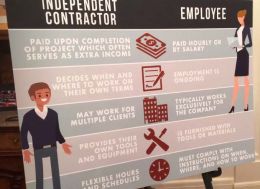To Be or Not to Be... An Independent Contractor
 | |
| Author | Jon Guerzon |
|---|---|
| Genre | Article, Business |
| Published | EF issue 2019.3 |
Publication date | Summer 2019 |
| Media type | Digital |
| Pages | 12-14 |
| Website | caricature |
This article appears in Exaggerated Features issue 2019.3. It can be found on page 14.
Contents
Article Transcript
I am not a lawyer.
I have not played one on TV.
I don’t think I have drawn one.
Do not consider my descriptions here as the final word.
Please consult legal advice for further information.
Overview
Simply said, the difference between independent contractors and employees is whether or not the entity paying for services has the right to control or direct the manner and means of work (tending to signify an employment relationship), or whether the person providing the services has independently made the decision to go into business for himself or herself (suggesting an independent contractor relationship). Independent contractors are not generally entitled to the same protections as employees.
The business may be required to give you Form 1099- MISC, Miscellaneous Income, to report the total amount paid to you.
You are responsible for paying your own income tax and self-employment tax (Self-Employment Contributions Act – SECA). The business does not withhold taxes from your pay. You may need to make estimated tax payments during the year to cover your tax liabilities.
You may deduct business expenses on Schedule C of your income tax return Form 1040.
For California artists, become familiar with the recent California Supreme Court decision in DYNAMEX v. Superior Court of Los Angeles.
What are you?
Under federal tax law, employers must prepare and provide employees with an IRS Form W-2. For independent contractors, however, an entity would instead complete an IRS Form 1099-MISC.
The IRS looks to common law tests to determine whether someone is an employee or an independent contractor. The common law test requires examination of all evidence of the degree of control and independence in the relationship. The facts would be examined as they relate to the following categories:
- Behavioral Control covers facts that show whether the business has a right to direct and control what work is accomplished and how the work is done through instructions, training, or other means.
- Someone who is required to complete assignments in a certain way at a certain place and time is more likely to be an employee than an independent contractor. If the entity receiving services provides training about required procedures and methods, this indicates the business wants the work done in a certain way.
- Financial Control covers facts that show whether the business has a right to direct or control the financial and business aspects of the worker’s job. This includes:
- The extent to which the worker has unreimbursed business expenses
- The extent of the worker’s investment in the facilities or tools used in performing services
- The extent to which the worker makes his or her services available to the relevant market
- How the business pays the worker, and
- The extent to which the worker can realize a profit or incur a loss
- In this area, the IRS would examine the following:
- Whether the worker pays his or her own expenses. That is more to be expected of an independent contractor than an employee.
- A significant investment by an individual into his or her own facilities, equipment, tools or supplies suggests the individual is in business for himself or herself rather than an employee.
- An independent contractor is generally free to seek out business opportunities. Independent contractors often advertise, maintain a visible business location, and are available to work in the relevant market.
- Someone in business for themselves may send out invoices to collect payment for services. An employee will receive a check at regular intervals.
- The ability of an individual to realize a profit or incur a loss suggests the person is in business for themselves.
- Relationship of the parties covers facts that show the type of relationship the parties had.
This includes:
- Written contracts describing the relationship the parties intended to create
- Whether the business provides the worker with employee-type benefits, such as insurance, a pension plan, vacation pay, or sick pay
- The permanence of the relationship, and
- The extent to which services performed by the worker are a key aspect of the regular business of the company.
- Behavioral Control covers facts that show whether the business has a right to direct and control what work is accomplished and how the work is done through instructions, training, or other means.
- Someone who is required to complete assignments in a certain way at a certain place and time is more likely to be an employee than an independent contractor. If the entity receiving services provides training about required procedures and methods, this indicates the business wants the work done in a certain way.
- Financial Control covers facts that show whether the business has a right to direct or control the financial and business aspects of the worker’s job.
This includes:
- The extent to which the worker has unreimbursed business expenses
- The extent of the worker’s investment in the facilities or tools used in performing services
- The extent to which the worker makes his or her services available to the relevant market
- How the business pays the worker, and
- The extent to which the worker can realize a profit or incur a loss
In this area, the IRS would examine the following:
- Whether the worker pays his or her own expenses. That is more to be expected of an independent contractor than an employee.
- A significant investment by an individual into his or her own facilities, equipment, tools or supplies suggests the individual is in business for himself or herself rather than an employee.
- An independent contractor is generally free to seek out business opportunities. Independent contractors often advertise, maintain a visible business location, and are available to work in the relevant market.
- Someone in business for themselves may send out invoices to collect payment for services. An employee will receive a check at regular intervals.
- The ability of an individual to realize a profit or incur a loss suggests the person is in business for themselves.
- Relationship of the parties covers facts that show the type of relationship the parties had.
This includes:
- Written contracts describing the relationship the parties intended to create
- Whether the business provides the worker with employee-type benefits, such as insurance, a pension plan, vacation pay, or sick pay
- The permanence of the relationship, and
- The extent to which services performed by the worker are a key aspect of the regular business of the company.
The following examples may help to properly classify your work or workers.
Example 1
Cameron Smith, an artist, is approached by Megatoons. Megatoons agrees to pay Cameron a flat amount to complete a one-time project to create a certain product. It isn’t clear how long it will take to complete the project, and Cameron isn’t guaranteed any minimum payment for the hours spent on the artwork. Megatoons provides Cameron with no instructions beyond the specifications for the product itself. Cameron and Megatoons have a written contract, which provides that Cameron is considered to be an independent contractor, is required to pay federal and state taxes, and receives no benefits from Megatoons. Megatoons will file Form 1099-MISC, Miscellaneous Income, to report the amount paid to Cameron. Cameron works at home and isn’t expected or allowed to attend meetings of the art development group.
Cameron is an independent contractor.
Example 2
Damon Blam performs art services in the art department of an art company. He works regular hours and is paid on a percentage basis. He has no investment in the art department. The art company supplies all facilities, art parts, and supplies; issues instructions on the amounts to be charged, techniques to be used, and the time for completion of each job; and checks all quotes and art orders.
Damon is an employee of the art company.
Example 3
An art agency furnishes space for Jen Bund to perform art services. She provides her own tools, equipment, and supplies. She seeks out business from art collectors and other individuals and does all of the artwork that comes to the agency. She hires and discharges her own helpers, determines her own and her helpers’ working hours, quotes prices for artwork, makes all necessary adjustments, assumes all losses from uncollectible accounts, and receives, as compensation for her services, a large percentage of the gross collections from the art sales.
Jen is an independent contractor and the helpers are her employees.
If you are not sure whether you or your worker should be classified as W-2 or 1099 for purposes of federal income tax withholding, you may request the IRS to make the determination for you. This is done by filing a request on IRS Form SS-8. The IRS will acknowledge receipt of your Form SS-8 and assign it to a technician to review, apply the law and decide. This may take up to six months.
According to an article from the Los Angeles Times, the hiring of workers as independent contractors has recently “exploded.” The article cites a 2016 study by economists that estimates that 12.5 million people, or 8.4% of the U.S. workforce, are now deemed independent contractors. In the interest of treating workers right and to avoid potentially hefty penalties, a business should take every precaution to ensure that they bring on independent contractors in a way that aligns with the law.
See Also
External Links
This Navigation box may not show up on mobile browsers. Please see Exaggerated Features Issue 2019.3 for the full contents of this issue if the navigation box does not display.


